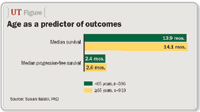Article
Outcomes similar in older, younger prostate cancer patients
Orlando, FL--Older men with hormone-refractory prostate cancer (HRPC) have a modest increase in risk of death compared with younger men, but only when age is considered as a continuous variable, a new study suggests. By contrast, when the same re-searchers evaluated risk of mortality in men categorized as less than 65 years and 65 years of age or older, no significant difference was found, according to the study, which was presented at the American Society of Clinical Oncology annual meeting here.

Susan Halabi, PhD, associate professor of biostatistics and bioinformatics at Duke University Medical Center, Durham, NC, and her colleagues Eric Small, MD, and Nicholas Vogelzang, MD, evaluated the impact of age on clinical outcomes in men with hormone-refractory disease by combining data from four phase II and four randomized phase III studies performed by the Cancer and Leukemia Group B between 1992 and 2003.
"The novelty of this report is that it is the first study that looks at this issue in this group of patients who have HRPC. Most studies evaluating the role of age do so in patients with localized prostate cancer," Dr. Halabi told Urology Times.
Of the 1,216 subjects evaluated, 910 (75%) were 65 years of age or older. The two groups of older and younger men were similar, except that older men were more likely to have had prior radiation than younger men (p=.01) and had lower alkaline phosphatase levels (p=.04).
The age factor
Dr. Halabi reported that the median survival time for older men of 14.1 months (95% confidence interval: 12.9 to 15.5) was similar to that for younger men: 13.9 months (95% CI: 12.63 to 16.8; p=.97). Likewise, the median time to progression also was not significantly different between the two groups: 2.6 months (95% CI: 2.4 to 2.8) and 2.4 months (95% CI: 2.1 to 2.8, p=.37), respectively.
In terms of survival, no overall difference in survival was seen between men 65 years of age and older and men younger than 65 years of age. The hazard ratio for overall survival, in multivariate analysis, was 2.57 (95% CI: 0.59 to 11.30, p=.21). However, when age was analyzed as a continuous variable, researchers observed a 7% increase in the risk of death for every 10 years of age (HR: 1.07 [95% CI: 1.00 to 1.1, p=.023]).
"Age is a very complicated variable," Dr. Halabi said. "Separating out age into <65 and >65 years is a naive way of studying the association. When we evaluated age as a continuous variable, we found there was definitely an increased risk of mortality with age, although it was only a modest increase."
Dr. Halabi and colleagues further analyzed these data; the analysis is under review for publication.
"In that analysis, we found that groups of men in their 50s and men aged 80 to 89 years were both at increased risk of dying relative to other age groups, but for totally different reasons," Dr. Halabi explained. "People in the younger group tended to have higher Gleason scores and were more at risk of dying due to disease, whereas members of the older group were more likely to die from other comorbidities. We don't really have enough data on comorbidities in this group, but that is what we suspect."















